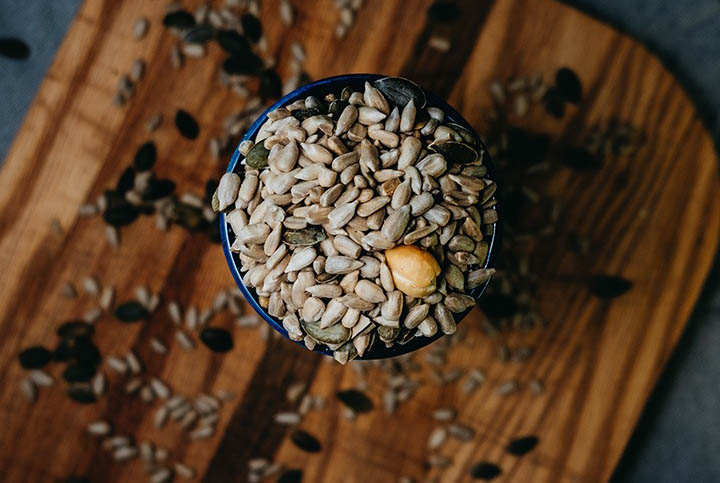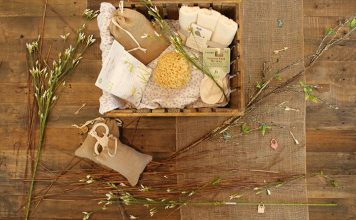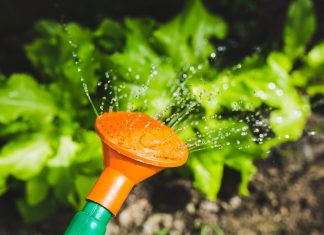 |
|
| Issue #100 • July/August, 2006 |
Even though it sounds a little seedy, planting an array of tasty seeds in your daily cooking is an economical way to sneak an extra dose of good health into your family’s diet without fuss or muss.
Nutritious seeds add delicious flavor and interesting texture to most any dish and are fun to experiment with. For the best of health, buy organically grown seeds.
Flaxseed
Cultivation of flax can be traced as far back as ancient Babylonian civilization where it was used as food and medicine as well as to make linen cloth; and throughout history flaxseed has held its ground as an important worldwide staple.
Herbalists use flaxseed as a remedy for stomach ailments and nervous disorders and as poultices for drawing infections from wounds.
My Grandmother, who sprinkled flaxseeds into the porridge pot every morning, has it noted in her doctoring journals that a daily dose keeps the system regular by flushing impurities from the body. She also has it written that flaxseed is good treatment for pimples, blackheads, psoriasis, eczema, and other skin problems.
|
Using flaxseeds in cooking is a tasty way to increase dietary fiber, vitamins, and minerals, but the best news is that flax is a number one source for Omega 1 and 3 essential fatty acids known as good fats.
Recent medical studies have indicated that North American diets are deficient in essential fatty acids, and one proven way to fill the Omega bill is by including flax in the diet.
According to research, Omega-rich flaxseed helps prevent coronary heart disease by reducing cholesterol, blood pressure, and plaque buildup. Flax not only promotes healthy cholesterol levels, but also aids digestion.
Since flaxseeds absorb about eight times their weight in water, they can be useful in weight-loss programs as their high-fiber content helps satisfy the appetite sensibly while increasing fat-burning power.
Flaxseeds contain more than two dozen identifiable cancer-preventative compounds that ward off and fight various cancers including breast and prostate cancer.
They are an abundant source of lignansa type of insoluble fiber that is useful treatment for menstrual cramps and symptoms of menopause.
The fatty acids in flaxseeds lubricate the joints, reducing inflammation and relieving arthritic pain. Studies have shown that folks with flax in their diet have better immune systems than those without, and some claim it helps calm migraine headaches.
Flaxseeds have a nutty flavor and can be eaten raw as in the days of early Greeks and Romans. Be sure to chew well to get out all the nutrients before they pass through.
They are excellent when sprinkled on salads, pastas, rice, cereals, cooked vegetables, baked potatoes, or used as thickening for soups and stews. They can be used whole to add nutrition and crunch to breads, rolls, cookies, and other baked goods. If you’re not looking for crunch, flaxseeds can be ground into flour and added to traditional flours to increase nutritional value.
|
Ground flaxseeds are a suitable substitute for eggs in baking recipes, making them popular with vegetarians or those who are allergic to eggs. One tablespoon ground seed mixed with three tablespoons of water equals one egg. Allow to stand for a few minutes to plump before adding to batter.
Because of their high content of beneficial oil, flaxseeds can be used to cut down on butter, shortening, or other fat in many recipes. Use one cup of ground seed to replace one-third cup of fat. The finished product may be somewhat moister and heavier in texture but much healthier on the table. This nifty trick is especially good for muffin and cookie recipes.
Even though flaxseed oil is fairly expensive, you can still cash in on its goodness by hunting down a bottle at a health food store and using it very sparingly. Unlike traditional kitchen oils, flaxseed oil is not intended for general cooking purposes, but can be used as a dietary supplement.
Try using a dab of flaxseed oil in place of, or mixing it in part with, other oils in salad dressings. Lightly brush it on cooked vegetables instead of melted butter, cheese, or other sauces. Brush over fruit wedges and sprinkle with ground cinnamon for an easy dessert or make super protein shakes for breakfast by adding a teaspoonful to the glass for a boost of energy. When used in this fashion, a small bottle will go a long way toward promoting good health and well being.
Sesame seeds
Like flax, sesame seeds are deeply rooted in history. The Assyrians believed that sesame wine instilled great strength and wisdom.
Babylonians used it for food, medicine, and cosmetic preparations, while in 8th-century China, seeds were eaten and used medicinally. Oil was burned as lamp fuel, creating soot prized by ancient Chinese calligraphic artists.
An Egyptian tomb depicts a baker sprinkling sesame seeds on bread, proving that the practice is as old as the hills.
In India, sesame oil has been used for centuries as a ceremonial anointment and the seeds called upon for treatment of piles as well as being a common kitchen condiment.
Brought to America by West African slaves in the 17th and 18th centuries, benne, as they are known in their native tongue, quickly took root in Southern cooking.
Today sesame seeds and oil are popular throughout the world, and one of the most traditional uses for sesame is in the making of tahini, a smooth creamy paste that is the basis for hummus, a wonderful Middle Eastern dip that’s delicious and healthy to boot (see recipe included).
In the olden days, herbalists used sesame seeds to expel worms from the intestinal tract. An Old World common cure for toothache and sore throat was to boil sesame seeds in water until all the oil was released, then used as gargle. I find that gargling with pure sesame oil works wonders at soothing sore throat and mouth. Do not swallow the oil as it will be contaminated with germs that have accumulated while swishing.
Modern herbalists recommend sesame to relieve constipation, aid digestion, and circulate blood. Sesame oil is often taken with medication to help distribute drugs evenly through the system.
|
They are a rich source of vitamins, minerals, and protein and contain an abundance of calcium, making them a good choice for building strong bones, teeth, and nails.
Because of their high vitamin E content, sesame oil works wonders at healing chronic skin diseases and soothing sunburn. A dab around the eyes at night prevents wrinkles, and a cotton swab dipped in warmed oil removes earwax. An old Chinese remedy for bug bites and burns calls for a simple paste of crushed seeds and water to be applied to the affected area.
Raw seeds are milder in taste than toasted ones, and some say they are more nutritious as heating may destroy some of the enzymes. Although they are nutritionally equal, in Asian kitchens black seeds are more prized than white.
To cash in on their goodness, try sprinkling raw or toasted seeds over steamed vegetables in place of butter or sauces. Add them to cookies, muffins, and other baked goods for nutritional bonus. Raw vegetables and fruits are delicious when squirted with lemon or orange juice then dipped into sesame seeds that have been seasoned with fine herbs like dill or chives or ground cinnamon.
To toast seeds, spread on cookie sheet and toast in oven at 350° F until golden. Do not roast until dark brown as protein will be lost in the process.
Sesame oil can be used sparingly to instill the wonderful taste and aroma of the Orient in any dish including stir-fries, soups, noodles, and rice.
One of my favorite recipes using sesame seeds is for Dukkaha delightful spice mixture that is a meal in itself, which comes from the Middle East (see recipe included).
Pumpkin seeds
“Peter, Peter, pumpkin eater, had a wife and couldn’t keep her…” probably because he was too darn quick for her to keep up with!
Pumpkin seeds are bursting with pep, and in China they are a symbol of fruitfulness. In folk medicine, pumpkin seeds have been used for centuries as preventive medicine and treatment for prostate disorders, and only in more recent years has the medical world taken a closer look at the beneficial effects of pumpkin seeds on the male system.
Modern-day research has shown that pumpkin seeds, which are a natural diuretic, contain a native plant hormone that is very beneficial to male hormone production. Seeds are reputed as having a regenerative, invigorative, and vitalizing influence. In countries like the Balkans and Eastern Europe, where seeds have been a common pocket snack for centuries, prostate problems are less prominent than in countries where the good word has not yet taken root.
Aside from being a readily available medicinal treat for men, herbalists recommend pumpkin seeds for bladder and urinary disorders, and Grandma claimed that pumpkin seeds were “good for the blood and soul.”
Pumpkin seeds are richer in iron than any other seed and are loaded with phosphorus. The best way to cash in on the goodness of pumpkin seeds is to carry a pocketful and enjoy whenever you need a nibble. A handful of pumpkins seeds a day is the most delightful way I know to boost vitamin and calcium intake.
Pumpkin and sunflower seeds are delicious, affordable trail treats to boost energy while backpacking or hiking, but when eating from the shell and using public trails, be courteous and carry out the waste rather than litter the walks with unsightly discards. My motto is, “one pocket for in, one pocket for out,” a simple lesson for teaching kids to pack out what they pack in.
To produce nutty breads, add raw pumpkin seeds to the dough, and for extra goodness, brush tops of loaves with oil and sprinkle generously with seeds before baking. They are delicious in cookies and muffins, add exciting crunch to cereal or porridge, and are a pleasant surprise in salads and yogurt.
Sunflower seeds
Sunflower usage dates back to the Incas, who worshiped the sun and the flower. North American Indians cultivated the plant from wild seed and made use of every part: the leaves as animal fodder; petals for dye; and seeds for food and oil.
In Russia, the plant is a major crop used for everything from food and fodder to lamp fuel and fertilizer. In the Old World, the leaves were used to treat malaria, and in China, fabrics are made from stock fiber.
|
Grandma’s old remedy for sore throat and bronchitis calls for equal parts crushed seeds and honey, along with a couple sprigs of mint, to be simmered in enough water to cover for an hour. The mixture is then strained, bottled, and taken by the teaspoonful. It tastes good and works!
Sunflower seeds are a source of phosphorus, magnesium, iron, calcium, potassium, and vitamin E. They also contain trace minerals, zinc, copper, and carotene, no doubt why Grandma claimed they were good for the eyes.
Use sunflower seeds in place of bacon bits on salads. Instead of using all meat in loaves and casseroles, substitute a portion of the meat with seeds. They’re economical and downright good. Add them to cookies, muffins, or breads. One of my favorite desserts is a bowl of tart applesauce crowned with crunchy sunflower seeds and a sprinkle of nutmeg.
Like flaxseed oil, sunflower seed oil is highly nutritious, and the good news is, it is affordable and intended for healthy cooking purposes. Sunflower oil is an excellent source of unsaturated fatty acids. Using the oil in place of other oil and fats for cooking and baking can help lower cholesterol deposits in the blood.
To plant some good health into your family’s diet, try the fun, easy recipes below.
Easiest-ever hummus:
2 cups cooked or canned chickpeas (if using canned, drain and rinse under cold running water)
juice of 1 lemon
5 ounces of tahini paste
4 cloves of peeled garlic
2 tsp. ground cumin
2 Tbsp. sunflower or traditional olive oil
sea salt and black pepper to taste
Put all ingredients in blender and puree until smooth, using a little water or cooking juice from the beans if needed. Serve with pita, crackers, or as vegetable dip. Serves 4 to 6.
Sesame and coriander dukkah:
Dukkah (“doo-kah”) is a spicy Middle Eastern creation that is made up of toasted nuts and seeds, herbs, and spices of choice. It is wonderfully versatile and can be made to suit any taste to a T.
The mixturewhich is always dryis served with pita (see recipe below) or other type of unleavened or flatbread bread and oil. In its homeland, it is sold on the street in little paper cups as a carry-away snack simply eaten with the fingers.
The first time I sampled sesame and coriander dukkah (simsim wa kuzbari) I fell in love with it. It makes an exotic, almost romantic, patio lunch and is a delightful picnic food, being spoil-proof and super easy to tote.
The secret to making perfect dukkah is in the grinding of the nuts and seeds. They should be processed fine in order to release all their flavor but not pulverized, as you do not want them to turn oily. So, whiz lightly when making dukkah. Have fun and experiment for no two dukkahs ever have to be the same.
When tightly capped, it saves very well, and the recipe below makes a big batchabout 12 to 16 servings. Keep it handy for a healthy quick snack or impromptu meal.
|
12 ounces sesame seeds
5 ounces coriander seeds
4 ounces coarsely chopped and lightly roasted hazelnuts
sea salt and coarsely ground black pepper to taste
Toast sesame seeds under oven broiler until just lightly golden, then set aside.
Spread coriander seeds on baking sheet and toast until flavor and aroma are released, about 2-3 minutes. Using a spice grinder or pestle and mortar, crush until fine.
In blender, lightly whiz hazelnuts. Add sesame seeds and coriander and twirl quickly for about a second; any longer and the nuts and seeds will turn oily. Add sea salt and pepper to taste. Recipe can be halved if you wish.
To serve: Pour a little flaxseed oil, sunflower oil, or traditional virgin olive oil into a little bowl or onto a flat plate. In another dish, pour out some dukkah. Dip an ear of pita into oil then dunk into dukkah.
A few other ways to plant seeds into your daily diet:
- In the cereal bowl. Seeds are wonderfully nutritious when added to the porridge pot, but you can also cash in on their goodness by sprinkling them onto any kind of dry cereal, such as corn flakes, to add zip and zap. Try toasted sesame, sunflower, pumpkin, or flax in the cereal bowl. It’s great.
- Seedy jello. When jello is partially set, stir in some seeds for a very unique treat. Kids love it.
- On sandwiches. Sprinkle sandwiches with seeds for enlivening crunch. A light spread of butter, mustard, or mayo helps hold the seeds in place. Great with deli meats, adds enlivening crunch to egg salad, and turns plain old jelly and jam into something worth talking about.
- In soups and salads. Better than croutons cause they don’t lose their crunch.
- On ice cream. You’d be surprised at how interesting a bowl of ice cream becomes when sprinkled with crunchy, chewy seeds.
- Seedy little snacks. Need just a little snack to take the edge off hunger pains? In a big jar, mix up all your favorite seeds. Add a few raisins, if you wish. Maybe even a scoop of chocolate chips, nuts, or shredded coconut. Shake well. A little pinch whenever you need it takes the sneak right out of snacking.



















